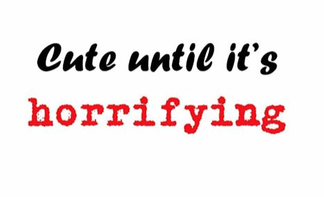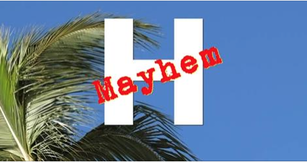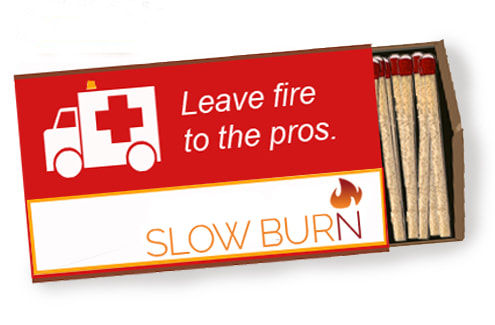 YES, IT'S TIME TO TALK ABOUT THE DECLINE OF WESTERN CIVILIZATION If the selfie stick, Kardashian mania and a profusion of Iggy Azalea videos hadn't already convinced you of the gradual death spiral of culture as we know it, Super Bowl 50 (because Roman numerals are too difficult for the populous--how's that for irony?) should have convinced you. Specifically, you should have been convinced by Mountain Dew's entry into the $5 million 30-second sweepstakes with the horrifying mashup creature whose tiny body dwarfs anything ever to come out of the mind of a glue-huffing Spanish surrealist monster-movie director. If you and your children ran screaming form the den, unable to ever unsee the hell that Mountain Dew hath wrought, you are not alone. Puppy Monkey Baby is now forever seared into our collective conscience as the vilest, most depraved and most cynically calculating commercial character ever to be released from the CGI vault of a major commercial production company. In case you haven't seen it, you may want to watch it now by clicking here. https://youtu.be/ql7uY36-LwA EEGAD, WHY IS THIS HAPPENING! Lest you think we here at the Mountaintop Marketing Fortress are late to the party in our desire to skewer and roast the Puppy Monkey Baby, that it's last week's news, know that we've been doing our best to forget it even existed. But it keeps cropping up. In conversation. In our media feeds. In the middle of the night when we awake, wondering whether that cat sitting at the foot of the bed staring at us in the dark really uttered the guttural phrase, "Puppy Monkey Baby!" And where is that infectious dance music coming from? But really, all of this aside, there is perhaps no better example of how Super Bowl advertising is both acutely applicable and utterly irrelevant to the curator of a small business brand. IGNORE THE CREATURE BEHIND THE CURTAIN! There ya go. Now you're going to forever have an image of the godforsaken, computer-generated spawn of a pug-head, monkey-body, baby-leg face licker lurking behind your living-room drapes. You're welcome. Puppy Monkey Baby in many ways was inevitable. Since Super Bowl advertising has become very much about social engagement, it's easy to imagine the conversation that probably led to this vile creation. "We need a meme!" "You know what happens whenever you try to create a meme--it flops on its side like a crippled minnow." "What are the most popular viral videos of all time?" "Well, the Oogachucka Baby was probably the first." "And people love pug dogs, especially the Super Bowl Doritos pug dog commercial." "And Career Builder's monkey commercials, the Trunk Monkey commercials, monkeys have always been huge." MASHING UP THE SUBJECTS OF THREE OF THE HUGEST VIRAL-VIDEO SUBJECTS EVER? Is it a no-brainer? Is it a huge mistake? And really, what have they done? Other than disturbing some of us into forever avoiding the soda aisle at Safeway? Well, here's one theory. They got people talking. Depending on whose statistics you want to believe, Puppy Monkey Baby was the single most engaging commercial in Super Bowl 50. Of course, a lot of those engaged were expressing their disbelief and horror. BUT WHO WAS THE TARGET CUSTOMER? Here's one safe bet: since the three guys in the commercial look to be in their early twenties, the likely target was teenagers. After all, there's nothing an 18-year old is more interested in being than a 21-year old. All kinds of doors are suddenly (legally) open. And are teenage boys watching this and thinking, "Ew, gross!"? Of course not. That's what their mothers are saying. Which makes the contrarian teen brain think Puppy Monkey Baby is even cooler. And there is no shortage of coverage about how this is one of the worst Super Bowl commercials ever. And you know what that means. EVEN COOLER FOR THE REBEL CONFORMIST! Because let's face it, that's pretty much how most of teenage rebellion works: finding a bunch of angry people who dress alike, dressing like them, and following them around. (No offense to the true teen rebels, some of whom I had the distinct pleasure to know back in the day.) "I want to be different, just like them!" And for the gross-out agers (younger kids who love gross humor and can legally buy an energy drink), this is a gateway product for getting them hooked. Sorry, is that too cynical? Here's the bottom line. It doesn't matter how many pundits tell us this is an awful commercial. WE HAVE NO IDEA ABOUT MOUNTAIN DEW'S STRATEGERY We can make guesses. But we are really, totally in the dark about what anyone there, at their $63 billion parent company or at BBDO New York was thinking. But it certainly generated a media buzz for a soft drink that gives you a caffeine buzz. And we can probably be guaranteed of this: everyone involved knew this was over-the-top borrowed interest. There is absolutely nothing about a Puppy Monkey Baby that is in any way relevant to Mountain Dew Kickstart. (You didn't even remember the name of the product, did you?) This is exactly the kind of thing a good class in advertising creative teaches you not to do. And they did it. Gleefully, no doubt. AND NOW IT HAUNTS YOUR DREAMS But what does it have to do with small business brand marketing? Not a whole lot. Unless you're looking for an example of how to break the rules. This is a hugely disruptive message. It is not an enormously salient message. But if we go back to the Trunk Monkey (something that was discussed here in the screed years ago), it's an example of how commitment to an irrelevant idea can ultimately lead to sales--especially if you're in a category where nobody has any idea how to differentiate themselves from the competition. If you've never seen these videos, the trunk monkey is a dealer-installed option on Subaru cars. Push a button inside the car, and the trunk pops open and a chimpanzee pops out. The "monkey" does things like defeat car theft, deal with irate drivers in traffic, and administer first aid. SEE ALSO: GEICO The vast majority of GEICO's advertising has nothing to do with auto insurance. But they've committed to their sense of humor, they always include their USP, and they spend horrifying amounts of money to make it work. Borrowed-interest advertising--the use of an irrelevant creative idea to drive a sales message--is always pointless. Until it isn't. Could you make something as insane and pointless as Puppy Monkey baby work in your own advertising? Maybe. We would also never recommend trying. But if you're going to try, you better have a strategy, tactics, and a seriously strong stomach. Because you're going to need it.
0 Comments
 IS YOUR NICHE BRAND MAGIC--OR MAYHEM? No, not like Mayhem, the Dean Winters character from the Allstate TV commercials. That particular Mayhem does not represent a niche, but in some ways does represent magic in a brand. (Research suggests it would be more magical if more people who recognized the Mayhem character could link him to Allstate. But that's another screed.) No, we're talking about the idea of a niche brand--a small, specialty brand with in-depth knowledge catering to a small, especially interested market. It's safe to say that you're reading the product of a niche brand. Slow Burn Marketing specializes in big-brand thinking for small business marketing. AND IF YOU'RE READING THE SCREED, IT'S SAFE TO SAY YOU OR YOUR BUSINESS MAY BE A NICHE BRAND Among the Hot Shots readership are: - a travel agent specializing in the golf tourism market; - a relocation resource specializing in serving the wives of professional athletes; - a consultant specializing in women competing in the pageant circuit; - a consultant specializing in making dental practices more profitable; - a beauty brand that specializes in serving holistic- and health-conscious women interested in a premium product; - any number of radio account reps who specialize in serving a niche in which they've decided to become an expert. IT'S SAFE TO SAY THAT THIS IS A NICHE-Y SCREED FOR THE NICHE-Y PROFESSIONAL And we've certainly seen potentially potent niche brands derailed by a lack of understanding about the niche being served. For example, a health & fitness brand came to us for consultation. The employees had gotten in touch and were lovely and enthusiastic. The brand needed help. They convinced one of the owners to take a meeting with us. We had a phone conference with that co-owner, who was delightful and excited at the idea of what we could do. Then, based on that conversation, we prepared a formal presentation and had a second phone conference with him and his business partner. IT WAS MAYHEM The business partner was headstrong, opinionated, and adamant that the brand was about one thing and one thing only--which should be good. But it was about one thing that nobody was buying. Which is bad. And the business partner didn't care. Which is worse. It was the business partner's way or the highway. You either liked what the business was selling the way it was being sold, or see ya later. The business was not flourishing. And there was nothing we could do about helping it. Flaming egomania in the brand was causing mayhem. AND NATURALLY, EVERYONE BUT THE PROBLEM CHILD COULD SEE IT Once upon a time, back in my radio days, we were helping to promote a cancer treatment center. We produced potent testimonials from patients who had been there for treatment and were singing its praises. We knew this was good stuff. It was filled with power and pathos. The work even went on to win a major national advertising award. One day, the account rep walks into my office. "The cancer treatment center says that in the last month, they've received only 47 phone calls." Hold on. We're promoting a specialty health clinic for people who think they're going to die, and they're complaining that they're getting only one to two calls a day on average? I asked, "How many of those calls have they closed?" "None." THAT, MY FRIENDS, IS A SIGN OF MAYHEM IN THE WAKE OF A MAGICAL ADVERTISING CAMPAIGN I was reeling. We were delivering high-quality leads from acutely interested prospects. And not one of those prospects had been willing to go there? I told the account rep, "Find out how they're answering the phone." So he did. And they weren't. Cancer patients in a life and death struggle were listening to the radio and hearing powerful tales of survival against the odds. So they were picking up the phone, calling the number--and were being greeted by an answering machine. TALK ABOUT BEING UNABLE TO LIVE UP TO THE PROMISE OF THE ADVERTISING When you're desperate, and someone offers you a bright and shining better reality--only to dash your hopes by playing you a recorded message? That is beyond inexcusable. You've taken your magic and cut it off at the knees, infusing your brand with mayhem. Often, a brand can solve the mayhem. For example, the cancer treatment center could easily find a warm body with the ability to talk to prospective patients and put that person on the other end of the phone line. But sometimes, the brand mayhem is beyond a business' ability to do much about it. LAST WEEK, WE TALKED ABOUT MEDICAL TOURISM IN PUERTO VALLARTA We had been down there and met with a warm and caring and personable doctor. He was helping patients from the US, UK and Canada have orthopedic surgery they otherwise couldn't afford at home. It was an eye opener for us. This man was extraordinary. And in last week's screed, the parting thought to you was: what is your perception of Mexico as a healthcare destination? One respondent presented an impassioned argument for never, ever going to Mexico for anything until it stops being a narco state. "Recently, a newly elected female mayor was murdered the day after she took office... Any support of this country in its current state should not be considered by anyone in the US." The two of us had a lengthy exchange, proving that, at least for some, the Mexico brand is riddled through with the mayhem of narco-state evil. THIS SAME RESPONDENT OFFERED AN ALTERNATIVE NICHE BRAND WITH ZERO MAYHEM AND A DEGREE OF MAGIC "I would probably choose the Cayman Islands and their brand-new Health City." Admittedly, while the idea of medical tourism is nothing new to me, this was the first I'd heard of the Caymans as a medical tourism destination. And who doesn't love the idea of the Cayman Islands? It's a tropical paradise! It's a British territory! It's an offshore banking haven! The Cayman Islands brand is mayhem-free! Our good doctor south of the border? HE CAN DO NOTHING ABOUT THE OUTSIDE MAYHEM AFFECTING HIS NICHE BRAND The best he can do is work in spite of it. His brand is a magical island in what, for many, is a sea of narco iniquity. Like having the Sotheby's real estate franchise for Detroit. Only worse. Interestingly, virtually all the responses avoided the question about Mexico's brand entirely, instead singing the praises of the medical tourism niche. One respondent spoke of his wife having her wisdom teeth removed in Cairo. It happened about the same time his two sons had their wisdom teeth taken out at home. "It would have been less expensive to send them both to Cairo to have the procedure done than it cost me in Dallas, Texas. "It may well turn out that medical tourism is what finally puts the brakes on runaway health costs in the US. "Or not. Seeing a taxing opportunity, our friends in Washington may slap a tariff on any medical procedures performed overseas.... "Is that cynical?" WELL, IT'S DIFFICULT TO NOT BE CYNICAL ABOUT THE HEALTHCARE & INSURANCE MESS HERE AT HOME Forgetting the challenges wrought by the Affordable Care Act (which many are finding not at all affordable), the RAND Corporation estimates $272 billion in fraud annually across the U.S. healthcare system. Not to mention that the system that is supposed to be about helping people get better can be adversarial when one chooses alternatives with which it doesn't agree. For example, one respondent talked about having her daughter's cancer treated in India. She had made the choice at the recommendation of a veteran US oncology nurse who had been there and witnessed extraordinary successes firsthand. "We sought healthcare outside of the US to avoid the 'one size fits all' approach as well as the complete disregard of therapeutic approaches that don't involve Big Pharma." BIG PHARMA. THERE'S A BRAND. SOME FEEL IT TO BE SINISTER. She says, "We bucked the system" and went "rogue." Instead of radiation and chemo, they addressed her daughter's health "through nutrition, homeopathy (which cost approximately $55/month), hyperbaric oxygen therapy and the rarely discussed emotional connection that impacts the health of the body." As for the US clinic to which she didn't disclose the rogue approach: "I don't have a lot of friends up there, but I do have a healthy and thriving child." And none of this accounts for the legal threats made to her because of her choices in curing her child. "I'm all for heading outside the border and have a very nice list of physicians in several countries that are providing great care... Should I become ill, my first call is to the travel agent. I only have a couple of physicians in Mexico on the list but I would definitely consider them." Magic. Mayhem. Mexico and medicine. Oh, my.  WHAT REALLY IS AFFORDABLE HEALTHCARE, ANYWAY? Here in the U.S., we have one of the finest healthcare systems in the world. And with the Affordable Care Act, the finest healthcare is more affordable than ever, right? Mmm... Well... Let's forget the politics for a moment. And let's forget the procedural challenges involved. From any other standpoint, the ACA brand is still problematic at best. So we're not going to dwell on all that. Instead... LET'S JUST SAY THAT YOU WANT A HIP REPLACEMENT And for whatever reason, you have to pay for that hip replacement yourself. In the U.S., that procedure will probably cost you around $50,000. But hey, quality of life, right? Can't put a price tag on that, can you? Not exactly. But you can definitely put a price tag on the act of healthcare. And $50,000 is way too much for a lot of Americans. SO, WHAT IF I TOLD YOU I COULD GET YOU THAT SAME PROCEDURE FOR 27 CENTS ON THE DOLLAR? But in all honesty, for almost one-quarter the price, you probably won't get the same experience. The cheaper experience might be better. The doctor might take more time with you. He might even have better training than the doctor you would normally visit. And what if, instead of just being hustled through the system, you actually were indulged? What if the doctor and the support staff all took their time with you? Moreover, what if you could enjoy your pre- and post-surgery time as an affordable vacation in a tropical paradise? Great food and activities galore--all for a fraction the price of what you'd normally expect to pay? SOUND GOOD? LET ME RUIN IT FOR YOU WITH ONE WORD. Ready? Mexico. Suddenly feeling different about it now, aren't you? If you're like many people we know, the idea of going to Mexico for amedical procedure holds zero attraction. All you can think of is a back-alley tattoo parlor in Tijuana with a flickering fluorescent light, a half-empty bottle of gold-ish liquor with a worm at the bottom, and a bent scalpel. For many Americans, Mexico has a distinct branding problem far worse than that of the Affordable Care Act. AND FOR AMERICANS, MEDICAL TOURISM IN MEXICO HAS AN EVEN BIGGER BRANDING PROBLEM To which a fair question would be: what do you actually know about healthcare in Mexico? "Well, the cartels! The drug wars! Narco violence! Drunken tourists in big, silly hats! Cheap tequila!" Well, allow me to share an experience the Fabulous Honey Parker and I had last week in Puerto Vallarta. Yes, the town whose name might conjure up an auditory memory of a game show host saying, "Johnny, tell her what she's won!" And Johnny gleefully announces a vacation in "sunny Puerto Vallarta!" OR MAYBE YOU THINK OF CAPT. MERRILL STUBING AND ALL THE CREW OF THE LOVE BOAT Anyway, Slow Burn was dispatched to lovely PV to discuss marketing with a gentleman we know from a previous project. This fellow has become involved with an orthopedic clinic, helping them raise their game in marketing to U.S., Canadian and UK patients with an eye on medical tourism. But there's more to be done for his client, which is where Slow Burn comes in. And frankly, it was a trip loaded with surprises. The first surprise was PV itself. Did you have any idea that Puerto Vallarta has been compared to Palm Springs and Fire Island, and is considered the San Francisco of Mexico? Yes, news to us, too. SORRY TO DISABUSE YOU OF ANOTHER POSSIBLE BRAND PRECONCEPTION We were staying in the funky, older part of the city known as La Zona Romantica. While we were there, we happened to have an extraordinary meal in a fine dining restaurant. It ranks as one of the top three gourmet meals I've ever experienced anywhere. And the price was about one quarter of what you'd expect to pay in New York. No, no tacos and beer that night. And yes, another brand preconception shot to hell. Anyway, medical tourism. IF YOU WERE UNAWARE, THIS IS A BURGEONING INDUSTRY It's not unique to Mexico. It's happening in South Korea, Thailand, Costa Rica, India--basically, anyplace you can think of where you probably hadn't thought about visiting. There are doctors in cities around the world who are making a fine living serving tourists who don't want to pay the high prices of medical care in their home countries. Which takes us back to the hip replacement done for 27 cents on the dollar in the middle of a tropical vacation. The doctor we met in Puerto Vallarta is a Canadian citizen of German extraction who has lived in Mexico since he was a child. HE IS ONE OF THE SINGLE MOST DELIGHTFUL MEDICAL PROFESSIONALS YOU'D EVER WANT TO MEET He speaks passionately of his adopted home town: "Vallarta has a magical power." And of the patient experience: "We have to treat them with our hearts." And of giving the patient a totally comprehensive experience in care: "We make a 6-month investment of time preparing, receiving and discharging a patient." His patient testimonials are glowing and extraordinary. "Dr. Smith and his professional and caring staff made my hip surgery the best decision I could have ever made." "I never knew a doctor as well as I do Dr. Smith...I was more informed going into surgery before and after than anything I had in the states. It seemed like in the states, I was on a need to know. Here, they answered any questions I had." "Clearly, Dr. Smith is focused on building relationships... His natural warmth and charisma contribute to a great bedside manner." There are dozens more like this. And they are everything you rarely get to hear about a patient experience in the U.S. So here's a question: what is your perception of Mexico as a healthcare destination? And what would it take for you to feel good about considering Mexico as an option for your own elective surgery? Feel free to send your replies to [email protected]  PERSONAL BRAND REDUX Last week, we dove into personal brand for a gentlemen who's a copywriter at a radio station group. Based on all the cards and letters and Facebook comments, some of you found that really useful, which is gratifying. And you may be glad to know we're venturing there again. Hard not to, really, when one receives a missive like this: "How about branding when it's just you who is the product? How do you brand a person who is, say, a Midwestern white woman and has no idea what the crap her brand is? "But enough about me. How about branding for solopreneurs when what they are selling is subjective, like art is to some people, not a hard and fast product? WE'VE SORT OF COVERED THIS BEFORE--BUT WAIT, THERE'S MORE I happen to know that the woman asking this question is an actor, so I'm going to infer that she's posing the question as an actor and an artist. The first part of this question is a really good one. How do you brand a Midwestern white woman who has no idea what her brand is? On the face of it, it sounds as if this woman is implying that "Midwestern white woman" is code for "dime a dozen," "uninteresting," or "boring." If that's the case, here's my first suggestion: tell that to Edie McClurg. That woman has made a fortune being a Midwestern white woman. If you don't know the name, you probably know her as Principal Rooney's secretary in Ferris Bueller's Day Off. She's the one with the upper Midwestern accent (don'tcha know), sniffing WiteOut at her typewriter and saying that Ferris Bueller is a "righteous dude." ONE DOES NOT GET MUCH MORE MIDWESTERN THAN EDIE The Fabulous Honey Parker and I know Edie, and can assure you: she is one extraordinary and hilarious woman. We've watched her at a party engage in competitive improv with another actor friend of ours, and it was one of the most relentless moments of live comedy we've ever witnessed. In fact, that other friend of ours has also been profiled here as a stellar example of personal brand. His name is M.C. Gainey, and his IMDB filmography lists all the characters he has played, from "Man In Cell" and "Big Jim," to "Tiny" and "Swamp Thing." He's a large man from Mississippi who (despite being a classically trained actor) has capitalized on his size and ability to seem dangerous. He could have easily said, "How does a big lug from Mississippi brand himself when he has no idea what the brand is?" WELL, WHAT ARE YOU GOOD AT AND HOW DOES THAT TRANSLATE INTO A CASTABLE PERSONA? Going back to the Midwestern white woman angle, Edie McLurg has absolutely defined her personal brand as the white woman with the cheery, upper-Midwestern accent. According to Wikipedia, she's been cast as that person in 90 films and 55 TV episodes. In fact, she apparently goes to auditions where she sees casting specs calling for "An Edie McClurg type." On a similar note, a friend and Hot Shots subscriber who can do big, booming comedy VO, once found himself in an audition for a "Gary Owens type," and he was sitting in the waiting room with Gary Owens. These are largely unassuming people who figured out a well-defined persona that makes the audience feel something. To which I ask... SO, WHAT'S YOUR PERSONA AS A MIDWESTERN WHITE WOMAN? You're obviously not Edie. She's got that covered. Are you the anti-Edie? Are you the sinister Midwestern mom? Are you the deadpan Midwestern spinster? Are you the Midwestern nuclear physicist mom? Especially in the world of casting actors, the more readily you can define your type, and the easier you can make it for casting directors and other decision makers to understand how they should feel about you, the more readily they can point and say, "That one!" See also last week's screed where we invoked the names of well-known comedians. SEE ALSO: CHARLES SPENCER CHAPLIN The man was a generalist. He was a performer in the tradition of British Music Hall and Vaudeville, a writer and a composer. When he was brought to the US by the prestigious Fred Karno company, he was scouted for the film business. So he eventually added "movie actor" to his resumé. But it wasn't until he took a huge pair of pants and an enormous pair of shoes from Fatty Arbuckle's wardrobe, and a too-small jacket from Harold Lloyd's wardrobe, added a cane and a bowler hat and a little brush mustache, that Charlie Chaplin became a huge-selling brand. His beloved and downtrodden little character, The Tramp, is iconic. He didn't say, "I can do everything, I shouldn't pigeonhole myself." Instead, he made his own pigeonhole and lived in it. OF COURSE, HE WAS ALSO IMMENSELY TALENTED--WHICH HELPS Chaplin was an artist of the first order. Which leads us to the second part of the actor's question, to wit: how to brand something subjective, such as art. It all goes back to everything said above, i.e. persona, and the requirement of focus. In the past, we've talked about the photographer of sun-drenched mountain landscapes, Ray Crosby. Ray Crosby's Sunmill Studios is (a) an art business, (b) distinctly about one kind of photography, and (c) about subjective appeal. It's calculated to make the customer feel one thing. And it's not for everyone. A lot of people would regard Crosby as "easy to like" and not be interested. Which is fine. Crosby doesn't care. He knows who his customer is and isn't worried about who his customer isn't. I also happen to know that Crosby, under another name, is also a sometimes sports photographer and a real estate photographer. That other name is Blaine Parker. THE RAY CROSBY BRAND IS A NECESSITY Blaine Parker can't possibly be taken seriously as a writer, a branding consultant and a VO performer as well as a fine art photographer. It's just too much. One of these things is very much not like the others. And art is so subjective, and the customer so needs to feel one thing and one thing only about the art, that the alter ego and standalone brand are a requirement. So, again, what is the one thing that the customer should feel about the brand? Sunmill Studios is so obviously about a "photographer of light" brand that there really isn't much question. The customer should feel captivated by rich, dense, vibrant sunrises, sunsets, mountain vistas, forests and snowscapes. If not, then that person is not the customer. Another example of a polarizing art brand is the late Thomas Kinkade, the Painter Of Light. His endless paintings of homes lit from within by a warm glow have sold for enormous amounts of money and made him a very wealthy man. FANS LOVE HIM. ART CRITICS HATE HIM. Which all goes to an important point: as long as your brand is authentic and resonant, it doesn't matter whom you alienate. It matters only that you appeal to the right person. Art critics hate you? No problem, as long as your well-defined art buyer loves you. It really doesn't matter what the business model is, as long as you understand your customer (the buyer) and make that person feel the right thing about your brand. Subjectivity be damned. You're never going to appeal to everyone. So don't try. Refine your brand and appeal to the one person who matters. You'll be much happier--and much wealthier. |
AuthorBlaine Parker is prone to ranting about any and all things related to brand. In many ways, he is a professional curmudgeon. While there is no known vaccine for this, the condition is also not contagious. Unless you choose it to be so. Archives
February 2022
Categories
All
|
|
© Copyright 2020 Slow Burn Marketing LLC |

 RSS Feed
RSS Feed

